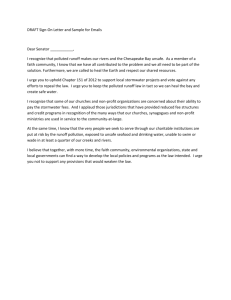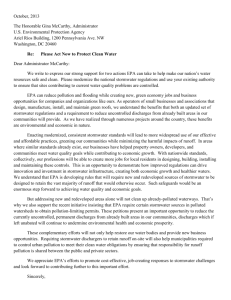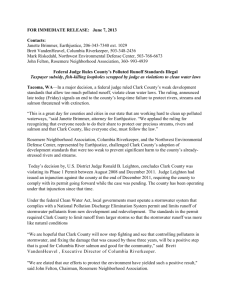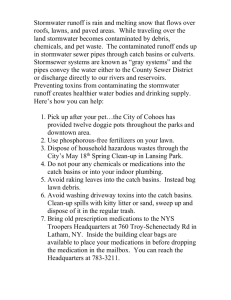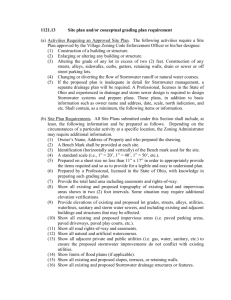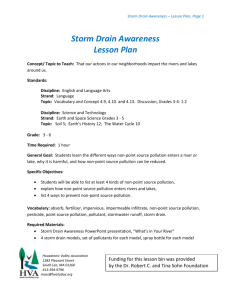background_information_sda_
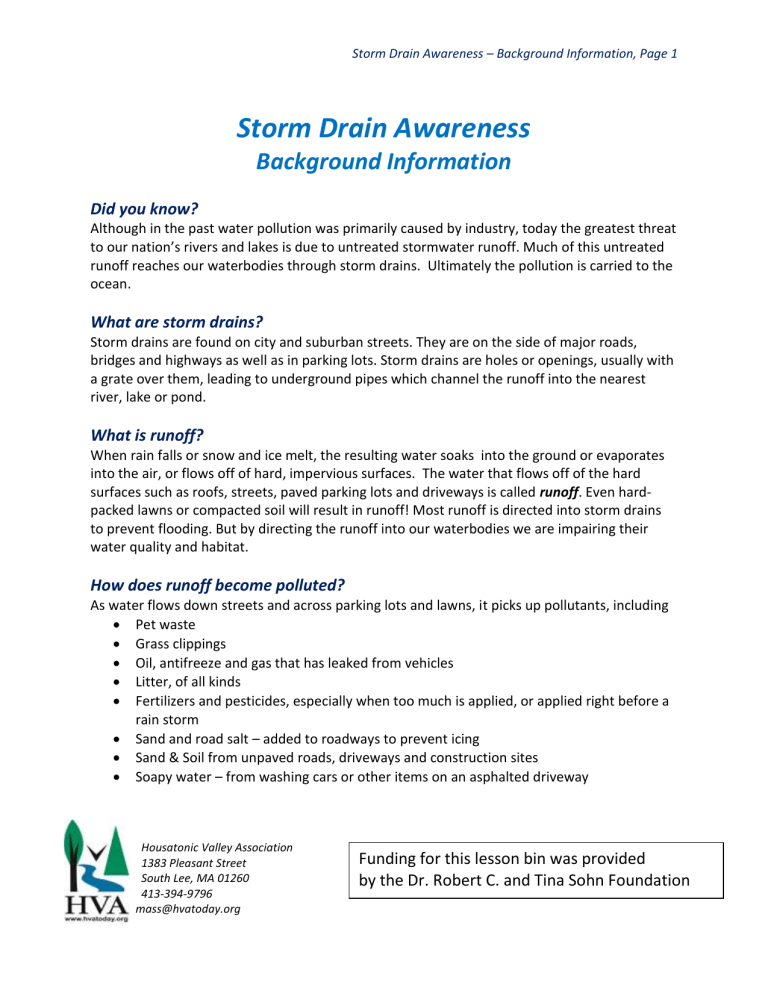
Storm Drain Awareness – Background Information, Page 1
Storm Drain Awareness
Background Information
Did you know?
Although in the past water pollution was primarily caused by industry, today the greatest threat to our nation’s rivers and lakes is due to untreated stormwater runoff. Much of this untreated runoff reaches our waterbodies through storm drains. Ultimately the pollution is carried to the ocean.
What are storm drains?
Storm drains are found on city and suburban streets. They are on the side of major roads, bridges and highways as well as in parking lots. Storm drains are holes or openings, usually with a grate over them, leading to underground pipes which channel the runoff into the nearest river, lake or pond.
What is runoff?
When rain falls or snow and ice melt, the resulting water soaks into the ground or evaporates into the air, or flows off of hard, impervious surfaces. The water that flows off of the hard surfaces such as roofs, streets, paved parking lots and driveways is called runoff. Even hardpacked lawns or compacted soil will result in runoff! Most runoff is directed into storm drains to prevent flooding. But by directing the runoff into our waterbodies we are impairing their water quality and habitat.
How does runoff become polluted?
As water flows down streets and across parking lots and lawns, it picks up pollutants, including
Pet waste
Grass clippings
Oil, antifreeze and gas that has leaked from vehicles
Litter, of all kinds
Fertilizers and pesticides, especially when too much is applied, or applied right before a rain storm
Sand and road salt – added to roadways to prevent icing
Sand & Soil from unpaved roads, driveways and construction sites
Soapy water – from washing cars or other items on an asphalted driveway
Housatonic Valley Association
1383 Pleasant Street
South Lee, MA 01260
413-394-9796 mass@hvatoday.org
Funding for this lesson bin was provided by the Dr. Robert C. and Tina Sohn Foundation
Storm Drain Awareness – Background Information, Page 2
How can polluted runoff harm rivers and ponds?
Runoff is not treated – It does not go to the wastewater treatment plant first. Any pollution picked up is transported directly into our waterways. Many people don’t realize this and dump trash, motor oil, soapy water and other contaminants down the storm drain. These contaminants destroy the water’s ecosystem and impair the habitat, even kill fish and other organisms living in the aquatic habitat.
What is being done about stormwater runoff?
Initially, when the Clean Water Act was established in 1972, the focus was on limiting point source pollution entering our waterways. This was pollution from factories and communities that were directly dumping their wastewater, chemicals, raw sewage and trash directly into the rivers. Amendments to the Clean Water Act in 1987 began to focus efforts on stormwater runoff. The primary method to control storm water discharges is through the use of best management practices. In response to the 1987 Amendments to the Clean Water Act (CWA),
EPA developed Phase I of the NPDES Storm Water program in 1990. The Phase I program addressed sources of storm water runoff that had the greatest potential to negatively impact water quality. The first phase addressed large cities. The second phase, often referred to as
“Phase II” requires medium and small cities, fast growing cities and those located near sensitive waters to take steps to reduce stormwater.
These laws require chosen cities to do six things: o Conduct outreach and education about polluted stormwater runoff. o Provide opportunities for residents to participate and be involved in conversations and activities related to reducting polluted stormwater runoof. o Detect illicit discharges (e.g. straight piping or dumping) o Control construction site runoff. o Control post – construction site runoff. o Take steps to prevent runoff from city buildings and activities
In the Housatonic watershed in Massachusetts, Pittsfield is the only community that is required by the Clean Water Act to better manage it’s stormwater by the above methods.
Pittsfield reports annually to the EPA.
What is Low Impact Development (LID)?
Low Impact Development practices attempt to restore the natural hydrology of an area allowing stormwater to infiltrate rather than run-off. In the case of new development, nature
Housatonic Valley Association
1383 Pleasant Street
South Lee, MA 01260
413-394-9796 mass@hvatoday.org
Funding for this lesson bin was provided by the Dr. Robert C. and Tina Sohn Foundation
Storm Drain Awareness – Background Information, Page 3 based site design can be used to maintain natural hydrological action and minimize stormwater runoff.
Examples include rain gardens (bioretention cells), permeable paving, green roofs and planting of vegetative buffers along rivers and lakes.
Sources
http://www.epa.gov/caddis/ssr_urb_is1.html
provides some basic information and good schematics about the effect of stormwater runoff on streams. http://water.epa.gov/learn/resources/bigpollutants.cfm
provides information about the top three water pollutants: soil, nutrients and bacteria http://www.epa.gov/npdes/pubs/nps_urban-facts_final.pdf
is an EPA publication entitled “Protecing Water
Quality from Urban Runoff”which provides basic information about the stormwater runoff problem. http://www.ncstormwater.org/pages/stormwater_faqspage.html#pollutedrunoff – provides basic information http://www.unh.edu/unhsc/ - Univerity of New Hampshire, Stormwater Center which is dedicated to protecting water resources through effective management of stormwater.
Housatonic Valley Association
1383 Pleasant Street
South Lee, MA 01260
413-394-9796 mass@hvatoday.org
Funding for this lesson bin was provided by the Dr. Robert C. and Tina Sohn Foundation

